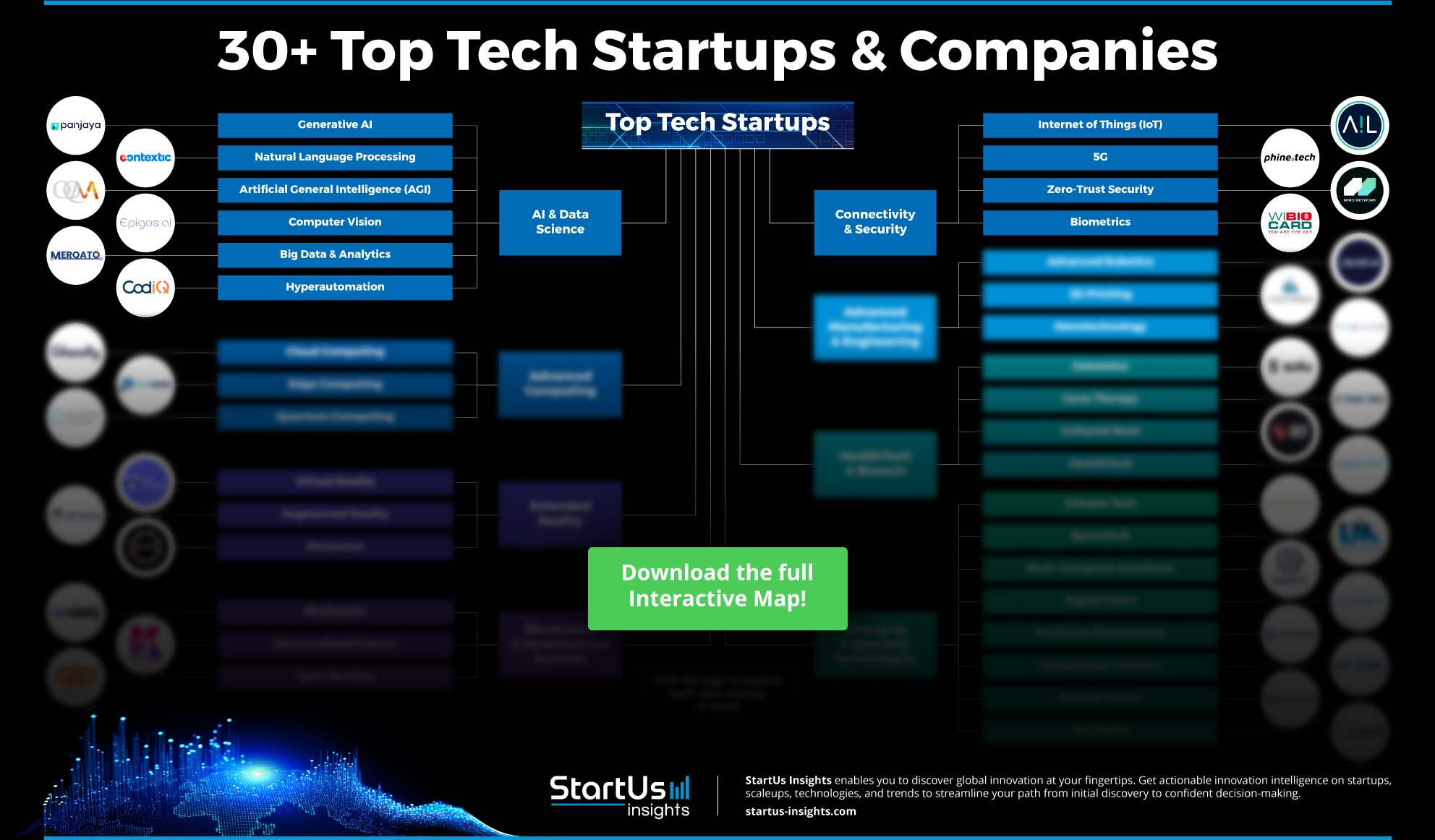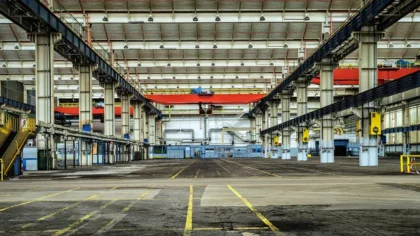The materials industry faces challenges like supply chain disruptions, sustainability demands, and rising operational costs. Advanced materials technologies, like AI-driven analytics, blockchain, and 3D printing, address these challenges by optimizing raw material sourcing, predicting demand fluctuations, and reducing waste. This approach also facilitates digital transformation in the materials industry. For instance, 3D printing enables rapid prototyping and customization to reduce production lead times and material wastage.
German startup Exomatter leverages data mining algorithms for the selection of new materials discovery which removes the time and money spent on manual trial-and-error methods. Similarly, Luxembourg-based AM4AM produces high-strength aluminium powder essential for additive manufacturing processes. This report showcases how emerging technologies reshape the materials industry and methods to integrate into the current practices.
Industry leaders must adapt to these emerging innovations, including augmented reality (AR), virtual reality (VR), big data, cloud computing, and more, to remain competitive and drive growth. They allow businesses to enhance efficiency, ensure sustainability, and navigate evolving market demands for success in the current market landscape.
Why should you read this report?
- Gain insights into the top 10 technologies impacting the materials Industry.
- Learn about three practical use cases for each technology.
- Meet 10 innovative startups advancing these technologies.

Key Takeaways
- Artificial Intelligence
- Use Cases:
- New Materials Discovery
- Predictive Modeling
- Quality Control & Defect Detection
- Startup to Watch: Exomatter
- Use Cases:
- Internet of Things (IoT)
- Use Cases:
- Advanced Materials Production
- Optimized Material Handling
- Data-driven Material Discovery
- Startup to Watch: Matix
- Use Cases:
- Advanced Robotics
- Use Cases:
- High Throughput Screening
- Precision Material Fabrication
- Consistency in Production
- Startup to Watch: Contour 3D
- Use Cases:
- Additive Manufacturing
- Use Cases:
- Complex Material Combinations
- Rapid Prototyping
- Waste Reduction
- Startup to Watch: AM 4 AM
- Use Cases:
- Augmented Reality (AR) & Virtual Reality (VR)
- Use Cases:
- Training and Skill Development
- Materials Design & Prototyping
- Remote Assistance and Maintenance
- Startup to Watch: Karax
- Use Cases:
- Blockchain
- Use Cases:
- Supply Chain Traceability
- Research Data Integrity
- Intellectual Property (IP) Protection
- Startup to Watch: Aware
- Use Cases:
- Big Data & Analytics
- Use Cases:
- Process Optimization
- Improving Sustainability
- Manufacturing Process Optimization
- Startup to Watch: Maxerial
- Use Cases:
- CleanTech
- Use Cases:
- Sustainable Materials
- Energy-Efficient Manufacturing
- Waste Recycling
- Startup to Watch: Myconom
- Use Cases:
- Connectivity Technologies
- Use Cases:
- Real-Time Process Monitoring
- Smart Manufacturing
- Worker Safety Monitoring
- Startup to Watch: Nanosen
- Use Cases:
- Nanotechnology
- Use Cases:
- Advanced Coatings
- Lightweight Composites
- Enhanced Barrier Properties
- Startup to Watch: Adaxius
- Use Cases:
Materials Industry FAQs
What is advanced material technology?
Advanced material technology involves the creation and manipulation of materials with specialized properties to meet specific engineering, environmental, or industrial needs. It focuses on developing materials at micro and nano scales to achieve high precision, reliability, and performance in challenging applications.
By incorporating innovations like nanotechnology, computational modeling, and material synthesis, advanced material technology enables the development of high-strength alloys, biodegradable polymers, and conductive composites. These materials play critical roles across sectors, including aerospace, healthcare, and renewable energy, due to their ability to withstand extreme conditions, improve efficiency, or reduce environmental impact.
What are examples of material technology?
Examples of material technology span a range of applications that solve industry-specific challenges. Carbon-fiber-reinforced polymers provide lightweight yet durable alternatives to traditional metals in industries like automotive and aerospace which reduces overall fuel consumption and enhances design flexibility.
Shape memory alloys, capable of returning to their original form after deformation, are widely used in medical devices, such as stents and implants that provides greater adaptability and biocompatibility. Additionally, graphene-based materials offer exceptional conductivity and strength, making them ideal for electronics, sensors, and energy storage, where both durability and efficiency are essential. Each example demonstrates how material technology advances functionality and product lifespan across diverse applications.
Where We Get Our Data From
StartUs Insights gathers data through its exhaustive Discovery Platform, covering information on 4.7 million startups, scaleups, and tech companies globally, alongside 20,000 emerging technologies and trends. The Discovery Platform accelerates startup and technology scouting, trend intelligence, and patent searches, offering thorough insights into technological advancements. By leveraging the trend intelligence feature for this report, we identified emerging technologies within specific industries. This process allows us to uncover patterns and trends, and pinpoint relevant use cases and the startups creating solutions for each scenario. Additional capabilities and information can be found at StartUs Insights Discovery Platform.
10 Technologies Impacting the Future of Materials Industry [2025 & Beyond]
1. Artificial Intelligence

By analyzing large datasets and projecting material properties, artificial intelligence accelerates the development of new materials. Machine learning models eliminate the need for time-consuming trial-and-error techniques by identifying promising materials appropriate for certain applications. By analyzing manufacturing data to find abnormalities, AI algorithms and datasets improve material synthesis, producing better qualities with less waste.
3 Practical Use Cases of AI in the Materials Industry
- New Materials Discovery: AI-powered platforms characterize new materials and their properties rapidly which saves time and money spent on sample preparation and analysis.
- Predictive Modeling: By simulating a material’s mechanical, thermal, or chemical properties, AI models forecast how the material will respond under different circumstances. This expedites the validation process and reduces the need for physical testing.
- Quality Control & Defect Detection: AI enhances quality control through advanced defect detection, predictive analytics, and continuous inspection process. They also facilitate material sorting and ensure compliance with industry standards in earlier stages of production.
Startup to Watch: Exomatter
German startup Exomatter utilizes AI-driven tools to modify new materials research and development and removes the need for labor-intensive trial and error. The company’s Exomatter platform employs data-mining algorithms to identify, assess, and recommend new materials based on specific performance criteria. This method improves the alternative material discovery process and cuts costs which enables a more effective search for potential solutions. Further, Exomatter enriches the available data from the platform by encouraging users to apply multi-dimensional search for new materials discovery. Exomatter’s technology also integrates extensive datasets, providing insights into material properties, compatibility, and sustainability.
2. Internet of Things

Internet of Things (IoT) aids the sharing of material data from connected devices enabling collaboration of research data and better output. IoT facilitates real-time data collection and remote experiment control. Integration of AI and machine learning with IoT sensors collects vast experimental data and uncovers patterns and predicts material performance.
3 Practical Use Cases of the IoT in the Materials Industry
- Advanced Materials Production: IoT sensors are placed in production settings for tracking essential variables like chemical composition, temperature gradients, and pressure in real-time. This ensures that materials like polymers, composites, and alloys are created under precise conditions, reducing defects and enhancing uniformity.
- Automation: In the material discovery process, IoT-driven automation simplifies repetitive tasks reducing human error, and also maintains more consistent experiment conditions.
- Data-driven Material Discovery: Systems using IoT gather information from various sources, such as thermal imaging and spectroscopy, during material assessments. This approach identifies new material features, such as improved thermal conductivity in composite materials or enhanced corrosion resistance in alloys.
Startup to Watch: Matix
Italian startup Matix creates industrial IoT devices, when attached to molds, provide precise production data using accelerometers to count the number of hits on the mold. They tackle the problem of excess material usage with their Matix dashboard, which chiefly employs artificial intelligence and machine learning algorithms to enhance asset management, ensure quality production of parts, and maintain robust supply chains. Parameters like shot counts, cycle times, temperatures, pressures, also mold location and utilization rates are constantly monitored, which helps reduce downtime and extend mold life.
3. Advanced Robotics

During the production of new materials involving hazardous substances or high temperatures, robots handle risky tasks, minimizing danger to human workers and allowing the exploration of a broader range of materials. Robotic systems enable continuous synthesis and testing of numerous material candidates, enabling immediate adjustments that optimize the material properties and increase the efficiency of the development cycle.
3 Practical Use Cases of Robotics in the Materials Industry
- High-throughput Screening: Robotics enhance high-throughput screening of material properties, testing thousands of combinations far more quickly than manual methods.
- Precision in Material Fabrication: Robotics delivers unmatched precision in fabricating materials on micro and nano scales. This is vital for developing advanced materials that require specific structural or functional characteristics, such as nanocomposites or metamaterials.
- Production Consistency: Robotics guarantee consistent production quality, which is essential when scaling new materials from the lab to full-scale manufacturing.
Startup to Watch: Contour3D
Australian startup contour3D merges 3D printing with robotics to create construction designs like columns, planter boxes, and architectural features. The company’s 3D printers utilize computer-controlled extrusion systems to deposit layers of concrete in a controlled manner. For this purpose, a robotic system that enhances precision and flexibility is used. This approach enables the production of both large-scale and finely detailed components with minimal human work. The company’s product Contourcrete is an environment-friendly construction material that has high recycled content and exhibits good toughness and durability.
4. Additive Manufacturing

3D printing allows the creation of intricate geometries and customized parts without specialized tooling. This flexibility produces unique and complex designs that traditional manufacturing can’t achieve. 3D printing meets the demands of localized manufacturing, producing parts with graded materials, minimizing waste, and developing sophisticated material combinations. It fosters new design possibilities by creating visible prototypes through digital designs.
3 Practical Use Cases of Additive Manufacturing in the Materials Industry
- Complex Material Combinations: 3D printing facilitates different material combinations in the production process allowing versatile properties for the fabricated parts. It allows precise and controlled deposition of various materials in a single process.
- Predictive Modeling: AI models simulate how materials respond to different conditions, anticipating their mechanical, thermal, or chemical attributes. This reduces physical testing and quickens the validation cycle.
- Waste Reduction: 3D printing utilizes only the necessary material to construct parts, decreasing waste compared to traditional machining. This efficiency is advantageous when working with expensive or rare materials, such as certain metals or composites.
Startup to Watch: AM 4 AM
Luxembourg-based startup AM4AM develops new materials through their patented cold plasma additive manufacturing process. The company’s product HiperAL powder focuses on applications where a balance between mechanical strength and lightweight is needed. The production of this high-performance metal powder involves an eco-friendly, scalable process and supports the generation of crack-free parts that find application in the automotive, aeronautical, and space sectors.
5. Augmented Reality (AR) & Virtual Reality (VR)

AR & VR facilitates the modeling of material characteristics and behaviors across various parameters. They forecast results, enhance compositions, and decrease the need for physical prototypes. By representing materials at the molecular or atomic level, crystal lattices of materials are seen with better visualization enabling a better understanding of material properties
3 Practical Use Cases of AR & VR in the Materials Industry
- Training and Skill Development: VR simulates how composite materials react under different stress conditions, which speeds up the identification of materials with desirable characteristics. It enables training on material reactions and how different additions of compounds affect materials.
- Materials Design & Prototyping: AR oversees the complete 3D printing process in real-time, fine-tuning factors like temperature, speed, and material feed rates to maintain consistent quality. They detect potential defects, optimize material use, and confirm that the final product meets strict specifications.
- Remote Assistance and Maintenance: Technicians use AR to receive real-time guidance for maintenance and repairs. This allows experts to remotely troubleshoot issues with equipment. As a result, AR reduces downtime and improves equipment efficiency.
Startup to Watch: Karax
US-based startup Karax uses digital twinning technology to assess the long-term durability of materials in harsh environments. The company’s technology utilizes deep learning engines to predict the properties of polymers and facilitate the design of new polymer materials. It models the aging of polymers and its impact on material performance across different applications. The software suites they create combine the laws of physics with expert insights into a central engine, serving as a tool for analyzing a wide array of polymer properties. The company offers computational tools under the product K-suite which has four variants in it. These products help in guiding predictive tools for quantifying the effects of various damage processes on the mechanical behavior of polymeric components

6. Blockchain

Blockchain improves transparency and efficiency in new materials discovery by enabling secure and traceable data sharing across research and development teams. This technology helps researchers track the origin and composition of materials, ensuring accuracy in experiments and collaboration. For example, experimental records are provided with a digital ledger enabling access to researchers and improving data integrity.
3 Practical Use Cases of Blockchain in the Materials Industry
- Supply Chain Traceability: Blockchain facilitates the records of the materials discovery process from selection to final production. This enables authenticity, proper data sourcing, and meeting regulatory requirements.
- Data Integrity: Integration of blockchain technology into existing workflows facilitates the protection of experimental data and ensures collaboration of research through intergratable sources.
- Intellectual Property Protection: Blockchain combines secure documentation and sharing of research data ensuring unauthorized access and proper ownership to projects.
Startup to Watch: Wearaware
Dutch startup Wearware develops blockchain-based traceability technology for sustainable textiles. The company’s system combines physical tracers into the clothes, which are scanned and validated at every stage of the supply chain. This approach ensures transparency by providing brands, and all the intermediate people in the business authenticity of textile products. Key features include the Aware Digital Product Passport, which tracks a product’s journey from fiber to final consumer. Wearware’s solution helps combat greenwashing by offering trustworthy data that enhances decision-making and boosts confidence in sustainable materials.
7. Big Data & Analytics

Big data reduces the time needed for new materials development by analyzing existing past data in a precise manner, which accelerates the discovery process and reduces the time and cost involved in the synthesis of new materials. It enables data-driven product design and development facilitating accurate simulations and new material combination analysis. This leads to better decision-making and improves the overall efficiency of the process.
3 Practical Use Cases of Big Data & Analytics in the Materials Industry
- Material Selection Optimization: Adoption of big data & analytics optimizes the material selection process by examining data from past sources, production logs, and quality control systems. This leads to better material properties, improved quality, and fewer resources used.
- Improving Sustainability: Big data helps researchers in the materials industry to track resource consumption, identify waste, and optimize energy use in the production process. This approach enables sustainable selection of materials and reduces environmental impact.
- Manufacturing Optimization: Big data allows manufacturers to collect and analyze data from sensors, machines, and other sources to optimize new materials production processes. Using this data, proactive maintenance, better product quality, and less downtime are achieved.
Startup to Watch: Maxerial
Liechtenstein-based startup Maxerial analyzes the complex structures of materials through the computed tomography technique. The company uses image analysis tools, and mathematical models to characterize various components and accelerate the development time of the product. By developing a digital twin of the component, the company offers precise insights into the structural integrity and performance of materials. This approach allows engineers to optimize designs for reduced size, weight, and better performance. It encourages non-destructive testing using X-ray analytics and quantifies the surface defect of the component.
8. CleanTech

Cleantech enhances the materials industry by adopting sustainable practices, fostering operational efficiency, and reducing environmental impact. It reduces the reliance on non-renewable resources by using renewable sources like solar, wind, and bio-energy in material synthesis. This allows the fabrication of smart materials and the life span of products. It allows waste resources to be recycled and promotes a circular economy.
3 Practical Use Cases of CleanTech in the Materials Industry
- Sustainable Material Development: It focuses on materials that do not harm the environment such as bioplastics and nature-inspired composites. They use renewable sources for production and decrease emissions into the environment.
- Energy-efficient Manufacturing: Materials manufacturing uses efficient production processes and incorporates waste heat recovery systems. This decreases energy used and operational costs, reducing its carbon footprint on the industry.
- Waste Reduction: Recycling technologies enable the recovery of raw materials reducing the dependency on numerous sources. This is especially relevant for circular economy models that foster recycling and reduced demand for raw material extraction in the materials industry.
Startup to Watch: Myconom
Turkish startup Myconom Labs produces biodegradable composite materials using mushroom mycelium. The company’s materials process the cultivation of mycelium, the root-like structure of fungi, which naturally binds with organic substrates to form strong, durable products. These mycelium-based composites offer fully biodegradable, low-cost, insulation against heat and sound. They serve as an eco-friendly alternative for industries like packaging and construction, minimizing waste and reducing environmental impact.
9. Connectivity Technologies

Networking systems and connectivity technologies impact the materials industry by enhancing efficiency, enabling smart manufacturing, and streamlining processes. It allows for the detection of defects, process inefficiencies, or material degradation, enabling quicker adjustments and reducing waste. They improve data collection and simplify optimal resource allocation of assets.
3 Practical Use Cases of Connectivity Technologies in the Materials Industry
- Real-time Process Monitoring: 5G and LoRaWAN enable real-time monitoring of raw materials, finished products, and machinery across production facilities. This improves inventory management, reduces waste, and ensures timely replenishment of materials.
- Smart Manufacturing: Connectivity technologies enable the integration of different stages of production, from material preparation to final product assembly. This allows for precise control of production parameters, leading to higher-quality materials and products.
- Material Behaviour Prediction: They allow researchers to perform complex simulations and calculations at faster speeds. Quantum simulations enable accurate predictions of material behavior.
Startup to Watch: Nanosen
German startup Nanosen develops force-sensor material based on polymer nanocomposites that support sectors like robotics, medicine, and industrial machinery. The polymer is based on silicone and combines flexibility, and high strength with a thickness of only 0.4 mm. The sensor material can measure 10 mg to 40 kg and the modular design exhausts scaling effects in manufacturing to offer a high-quality product at a very low unit price. Sensor material is produced as bulk sheets with uniform conductivity, which can be easily cut to size and integrated into various designs.
10. Nanotechnology

Nanotechnology inspects materials at the atomic level to improve their properties and enables new materials development. It fosters the development of functional materials with responsive capabilities, such as materials that change properties in response to environmental stimuli. They produce lightweight materials, lower costs and save energy.
3 Practical Use Cases of Nanotechnology in the Materials Industry
- Advanced Coatings: Nanotechnology enables the creation of coatings with properties such as corrosion resistance, UV protection, anti-scratch, and self-cleaning. Also, these coatings extend the lifespan of materials and improve their performance in harsh environments.
- Lightweight Composites: By integrating nanomaterials into composites, manufacturers produce lightweight yet strong materials. These composites find applications in sectors like aerospace, automotive, and sports equipment, where reducing weight without compromising strength is crucial.
- Enhanced Barrier Properties: Nanotechnology improves barrier properties in packaging materials, making them more resistant to gases, moisture, and contaminants. This is especially beneficial in the food and beverage, pharmaceuticals, and electronics industries, ensuring product quality and shelf life.
Startup to Watch: Adaxius
US-based startup Adaxius utilizes nanotechnology for fabricating carbon nanotube (CNT)-based composites. It uses a proprietary process to modify the surface properties of carbon materials, enhancing their compatibility and performance in composite applications. This process results in composites with improved mechanical properties, including increased strength, and durability and making them lighter. This process of surface modification aims to deliver not only high-performance materials but also solve the needs for use in demanding fields such as aerospace, automotive, and industrial applications.
Outlook for the Materials Industry
Patents & Grants
The materials industry demonstrates robust R&D and innovation, with over 486,000 patents and 36,000+ grants shaping technological advancements. These figures underscore a strong focus on intellectual property development and underscore the sector’s commitment to pioneering research.
For more actionable insights, “Download our free Materials Innovation Report” .
Investment Landscape
Prominent investors include Techstars, SOSV, MassChallenge, and Antler. Key funding types encompass Seed, Accelerator/Incubator, Early Stage VC/Series A, Pre Seed, and Angel, with an average funding amount of USD 22 million per round.
Global Footprint
Key hubs span the USA, India, Germany, the UK, and China, with major cities like New York City, London, Mumbai, Singapore, and Sydney driving innovation. This global distribution reflects the industry’s expansive reach and its diverse approach to advancing materials technology.
Don’t Miss Out on the Latest Materials Innovations
Ready to leverage the latest Materials technologies shaping the future? With StartUs Insights, you gain quick and easy access to over 4.7 million startups, scaleups, and tech companies, along with 20,000 emerging technologies and trends. Our AI-powered search and real-time database provide exclusive solutions that set you apart from the competition.
Industry giants like Samsung, Nestlé, and Magna trust our innovation intelligence tools to lead trends, optimize operations, and uncover new market opportunities. Benefit from our unmatched data, comprehensive industry views, and reliable insights to drive strategic decision-making. Get in touch to learn how our tailored discovery options can accelerate your innovation journey.
Discover All Materials Technologies & Startups!









